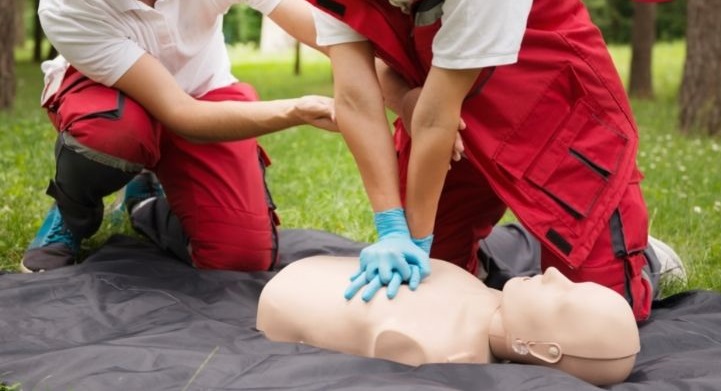Introduction
In our hectic globe, emergencies can strike without caution. Whether it's a minor injury, a medical emergency, or a lethal situation, understanding how to provide emergency treatment can make all the distinction. This is where a First Help course comes into play. Many individuals might question what they can gain from such training, and this short article aims to shed light on that.
By joining in a First Help and CPR course, you do not just learn more about wrapping injuries or performing CPR; you equip yourself with indispensable abilities that might save lives. So, what exactly will you learn in an extensive training course? Allow's study the details.
First Aid Essentials: What You'll Find out in a Comprehensive Course
Understanding First Aid
What is Very first Aid?
First help describes the preliminary aid offered to a person struggling with an injury or ailment until professional medical aid arrives. It encompasses numerous methods and skills varying from basic wound care to lifesaving strategies like mouth-to-mouth resuscitation (Cardiopulmonary Resuscitation).
Importance of First Aid Training
Why Needs to You Take a First Aid Course?

Taking a First Aid course is vital for a number of reasons:
- Confidence: Recognizing just how to react in emergencies can instill confidence. Life-Saving Skills: The ability to perform mouth-to-mouth resuscitation or help with choking can save lives. Career Advancement: Lots of careers call for accreditation in initial aid. Community Obligation: Learning methods you can assist others effectively.
Overview of CPR
What is CPR?
CPR, or Cardiopulmonary Resuscitation, is an emergency procedure carried out when a person's heart beat or breathing has stopped. It incorporates chest compressions with rescue breaths to preserve blood flow and oxygenation up until specialist assistance arrives.
The Structure of a Comprehensive Emergency Treatment Course
What Does an Emergency treatment Course Include?
A well-shaped First Help and CPR course usually covers the following subjects:
Introduction to First Aid Legal and Moral Considerations Scene Safety Basic Life Support (BLS) CPR Techniques Choking Relief Wound Treatment Management Burn Treatment Managing Shock Recognizing Medical Emergencies Using an Automated External Defibrillator (AED)Legal Elements of First Aid
Are There Legal Effects Associated With Offering First Aid?

Yes, giving first aid does lug legal obligations known as "Do-gooder legislations." These legislations protect people who help others in emergency situations, provided their actions are affordable and not reckless.
Scene Security: The First Step
How Do You Make sure Scene Safety?
Ensuring scene safety and security includes assessing the atmosphere prior to coming close to the sufferer:
- Look for prospective threats (traffic, fire). Make sure it's safe for both you and the victim.
Basic Life Support (BLS)
First Aid Course BelmontWhat Duty Does BLS Play in Emergency Situation Situations?
Basic Life Support includes the basics of preserving life features until more medical assistance gets here. This section covers local first aid course Newcastle vital abilities such as:
- Checking responsiveness Activating emergency services Performing top quality chest compressions
Advanced mouth-to-mouth resuscitation Techniques
What Are Advanced Techniques Covered in CPR Courses?
Advanced techniques might consist of:
- Two-rescuer CPR Use of barrier gadgets for rescue breaths Special considerations for infants and kids
Choking Alleviation Techniques
How Do You Assist Someone That is Choking?
Choking alleviation entails two critical techniques:
The Heimlich maneuver for adults. Back strikes and upper body thrusts for infants.Wound Treatment Management
How Do You Effectively Handle Wounds?
Effective wound monitoring entails:
- Cleaning the injury with saline or tidy water. Applying antibiotic ointment. Covering it with sterilized dressings.
Burn Treatment
What Work Methods for Treating Burns?
Burn therapy varies by degree:
Cool the melt under running water. Cover it with non-stick dressings. Seek medical interest for extreme cases.Managing Shock
How Is Shock Recognized and Treated?
Recognizing shock includes seeking symptoms like pale skin, fast pulse, or complication:
Lay the individual down. Elevate their legs unless there are injuries preventing this. Keep them relax until help arrives.Recognizing Medical Emergencies
What Types of Medical Emergencies Must You Understand Of?
Common clinical emergencies include:
- Heart strikes Stroke Severe allergic reactions Recognizing these problems assists you act quickly.
Using an Automated External Defibrillator (AED)
How Do You Use an AED Correctly?
Using an AED includes turning it on, connecting pads according to illustrations on the tool, and following voice motivates carefully.
Importance of Continual Learning
Why Is Continuous Knowing Important in First Aid Training?

Continuous learning guarantees you stay updated on ideal techniques and new protocols in first aid care.
FAQs About First Aid Courses
What Is Included in a Criterion First Aid Course?- A standard course usually covers standard life support, wound management, choking alleviation strategies, and lawful considerations.
- Most courses range from 6 hours to 16 hours relying on the deepness of material covered.
- Yes, upon successful completion of most training courses, participants get a first aid certificate, which is usually legitimate for two years.
- Yes! Many companies provide on the internet training courses that offer versatile knowing settings while still being effective.
- Absolutely! Hands-on method is crucial for understanding skills like upper body compressions and utilizing AEDs effectively.
- Generally, there are no age restrictions; however, individuals need to be mentally competent to learn these life-saving abilities effectively.
Conclusion
Enrolling Fremantle first aid training in a comprehensive first aid course equips individuals with vital understanding that can save lives throughout emergency situations-- whether in the house, work, or out in public spaces! From understanding basic life support procedures such as mouth-to-mouth resuscitation to learning exactly how to manage injuries correctly or identify indicators of shock-- these courses supply very useful training that any individual can benefit from!
As we browse through our lives loaded with unpredictability-- what much better method than preparing ourselves with understanding obtained from structured training sessions concentrated on saving lives?
In final thought-- if you're contemplating using up any type of first-aid training-- never hesitate! Equip yourself today with these powerful devices due to the fact that preparedness absolutely makes all the distinction when every second counts!